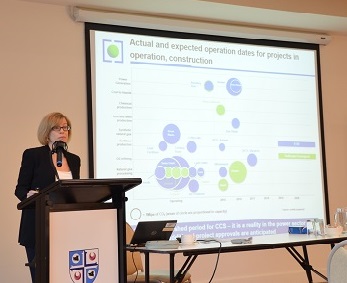Insights and Commentaries
Capture technology development: Evolution versus Revolution?
15th June 2015
Topic(s): Carbon capture, CO2 capture, Engineering and project delivery, use and storage (CCUS)
The capture element of carbon capture and storage (CCS) accounts for the majority of the cost in the CCS chain. As CCS costs fall over the coming years, this will largely be driven by cost reductions in capture processes. A number of different technologies are available for capturing carbon dioxide (CO2) from flue gas. These are the subject of the HiPerCap project, a collaboration between Australian and European researchers. In this Insight Dr Paul Feron, Science Leader at Australia's Commonwealth Scientific and Industrial Research Organisation (CSIRO) discusses some of the different capture technologies presented at a recent HiPerCap workshop.
It is common knowledge that in a carbon capture and storage (CCS) chain the capture step is the costliest one, with transport and subsequent storage of carbon dioxide (CO2) being a smaller component of overall cost. Reducing the cost of CCS is therefore almost synonymous with development of cheaper capture processes. In several countries, notably the United States (US), Canada and China, the option of CO2-utilisation in enhanced oil recovery (EOR) can provide a financial incentive in CCS projects. For large parts of Europe and Australia this option is not available and other incentives will be required to stimulate CCS technology deployment.
HiPerCap
It is against this background that the European Commission (EC) and the Australian Commonwealth engaged in a bilateral dialogue, which resulted in a dedicated call in the final stages of the European Union (EU)-FP7 programme in which collaborative EU-Australian project proposals were invited. The response to this call was very positive, resulting in six collaborative projects being kicked-off in late 2013/early 2014. CSIRO is a full participant in one of these projects called HiPerCap (High Performance Capture) coordinated by the Norwegian research organisation SINTEF. As such we hosted a joint workshop on Breakthrough Post-Combustion Capture Technologies in Melbourne organised by the HiPerCap consortium. The workshop was held on 25-26 March. Supported by the Global CCS Institute, it was attended by 70 people with a quarter coming from Europe.

Global CCS Institute General Manager for Asia Pacific, Clare Penrose, presents an update on international CCS development at the HiPerCap workshop. Picture courtesy of SINTEF
International workshop
The purpose of the workshop was to present not only the results of the HiPerCap project, but also the results from other CCS projects in Europe and Australia and to create synergies on CCS between R&D organisations and industry from Europe and Australia.
The three major separation technologies (absorption, adsorption and membranes) were presented in three separate sessions and one session dealt with methodologies for technology assessment and benchmarking. Two panel sessions were devoted to the discussion of recent trends for technology development within the three major types of gas separation as well as methodologies for technology evaluations. All presentations are publicly available and the full workshop proceedings are available on the HiPerCap website.
A site visit to the Latrobe Valley to view AGL Loy Yang power station and mine as well as the CSIRO capture pilot plant connected to the brown coal-fired power station was conducted on 27 March. This trip was sponsored by Brown Coal Innovation Australia (BCIA).
Capture technologies
The workshop provided an excellent overview of several emerging technologies, ie technologies which could be available for deployment at scale in a decade or so. There was large focus on the alternatives for the ubiquitous amine based CO2-separation processes, such as those based on solid sorbents and membranes. Considerable work is aimed at making these novel capture agents more robust in a flue gas environment.
The discussions highlighted the need to also develop suitable process and equipment designs, ie able to treat large volume flows at low energy costs. The amine based process benefits from the fact that new amines can be easily implemented in existing processes and conventional process designs, which facilitates the scale-up and commercial deployment. For solid sorbents rotating wheels are currently considered the most suitable for scaling up, as this equipment concept is widely used for gas-gas heat transfer duties in power plants. The application of solid sorbents in structured geometries, eg mono-lithic structures, is vital for use in rotating wheels.
Membranes represent perhaps the simplest capture principle, because they do not require the cyclic operation of ab/adsorption in one stage, followed by desorption in another stage. However, they do require a differential pressure for the separation to occur. Scalable membrane module designs and process concepts able to operate in flue gas still require extensive development. For any type of new capture agent the workshop discussion pointed towards the necessity to perform early testing under realistic conditions. Testing facilities at power plants are crucial in the early evaluation of new capture agents.
Amine regeneration
For amine-based capture processes the energy requirement for absorbent regeneration is the largest contributor to the energy penalty of a capture process. At the workshop two radically different solutions were presented to circumvent this. TNO is working on the use of algae for regeneration of the liquid absorbents and simultaneous production of chemicals. CSIRO has started work on the direct use of sunlight for regeneration of amine solutions loaded with CO2. Both technological ideas have the potential for an extremely energy efficient process. Both are also based on the use of a standard amine based technology to capture CO2 from flue gases as the first step.
This leads me to make the following final thought: if there is such a concept as the ultimate capture process, it requires most likely an optimum combination of evolutionary progress and revolutionary concepts to break through the cost barriers. Let’s get on with!